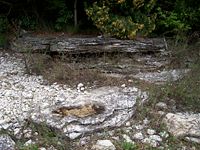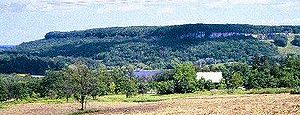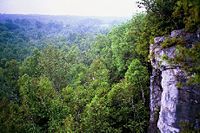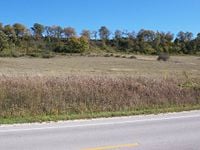Difference between revisions of "Niagara Escarpment" - New World Encyclopedia
({{Contracted}}) |
|||
| Line 28: | Line 28: | ||
[[Hamilton, Ontario]] is situated on the escarpment in such a way that the north end of the city is below and the south part above. Affectionately referred to as "the mountain" by its residents, the escarpment is both an attraction and a hindrance to everyday life. Bridging the divide are a number of roads or "mountain accesses" that separate the urban core below from the suburban expansion above. | [[Hamilton, Ontario]] is situated on the escarpment in such a way that the north end of the city is below and the south part above. Affectionately referred to as "the mountain" by its residents, the escarpment is both an attraction and a hindrance to everyday life. Bridging the divide are a number of roads or "mountain accesses" that separate the urban core below from the suburban expansion above. | ||
| + | |||
| + | ==Ontario Greenbelt== | ||
| + | The Greater Golden Horseshoe - that area wrapping around the western end of Lake Ontario - is one of the fastest growing regions in North America. Over the next 30 years, its population is expected to increase to about eleven million people from almost eight million. | ||
| + | |||
| + | Accommodating the needs of this rapidly expanding population without sacrificing the value and character of the region’s countryside, open space and rural communities will be a significant challenge. | ||
| + | |||
| + | To meet this challenge, Ontario has created the Greenbelt. | ||
| + | |||
| + | Our living countryside | ||
| + | |||
| + | The purpose of the Greenbelt is to protect environmentally sensitive land and farmland from urban development. | ||
| + | |||
| + | The Greenbelt celebrates rural life ensuring towns and villages remain intact. It is essential for providing clean air and clean water to cities. Its trees act as “lungs” for a wide area, and filter air pollution, while rivers and streams feed sources of drinking water for millions of people. | ||
| + | |||
| + | Greenbelt Facts and Figures | ||
| + | |||
| + | The Greenbelt protects 1.8 million acres (720,000 hectares) of countryside. | ||
| + | |||
| + | |||
| + | The Greenbelt extends 325 kilometers from Rice Lake in Northumberland County to the Niagara River. | ||
| + | |||
| + | |||
| + | Farming is the dominant land use in the Greenbelt and farmers are the dominant land owners at just over 50%. | ||
| + | |||
| + | |||
| + | The Greenbelt’s natural heritage system protects about 535,000 acres of lakes, wetlands, river valleys and forests. Habitat is protected for wildlife and endangered species within a continuous band of green countryside. | ||
| + | |||
| + | |||
| + | Open space is maintained for tourism, recreation and healthy living. Over 50% of people living in central Ontario are likely to take advantage of the tourism and recreation possibilities of the Greenbelt - hiking, camping, skiing, fruit-picking, wine-tasting, holiday tours, spas and more. | ||
| + | |||
| + | |||
| + | Agriculture in the Greenbelt | ||
| + | |||
| + | |||
| + | There are approximately 7000 farms in the Greenbelt. Farming is still largely a family affair, with the majority being the sole proprietors. | ||
| + | |||
| + | |||
| + | The Greenbelt preserves some of the most valuable agricultural lands in Canada, providing fresh fruits and vegetables, dairy, beef, pork and poultry products and grapes for prize-winning wines. | ||
| + | |||
| + | |||
| + | Specialty farms in the Greenbelt produce everything from sheep and lambs, mushrooms, maple syrup, and horticultural goods (flowers and plants). | ||
| + | |||
| + | |||
| + | On a regional basis, Greenbelt farms are smaller than the average Ontario farm by 33%, but per hectare the lands are more productive producing 12% more in gross income. | ||
| + | |||
| + | |||
| + | The Greenbelt produces over one quarter of Ontario’s apples (26.57%); 87.63% of Ontario’s peaches; 50.04% of Ontario’s sour cherries; over 85% of Ontario’s grapes; and 42.59% of Ontario’s raspberries. | ||
| + | |||
| + | |||
| + | The Holland Marsh is Ontario’s vegetable basket. Main crops are carrots and onions. Other crops include lettuce, celery, potatoes, cauliflower, beets, radish and parsnips. Enough carrots are grown in the Holland Marsh to provide every man, women and child in Canada with four pounds every year. | ||
| + | |||
| + | |||
| + | There are approximately 1118 beef farmers in the Greenbelt, which account for about 16-18% of the farms, with the highest concentration in Durham Region (40%). | ||
| + | |||
| + | |||
| + | The Greenbelt protects about 100,000 acres of the Niagara Peninsula Tender Fruit and Grape Area. The Niagara Peninsula is the world’s largest and best producers of icewine. | ||
| + | |||
| + | |||
| + | Niagara’s 2.1 million tender fruit trees (peaches, pears, plums, cherries, grapes) produce about 800,000 baskets of fruit that would stretch along the QEW from Kingston to Niagara Falls. | ||
| + | |||
| + | |||
| + | In 2005, the Niagara Escarpment’s Bruce Trail was connected with the Oak Ridges Trail making it possible to hike from Rice Lake, South of Peterborough, to Queenston and up to Tobermory on Georgian Bay. | ||
| + | |||
| + | |||
| + | The amount of farmland decreased by 7% in the Greater Toronto Area and 6% in the Hamilton area between 1996 and 2001. | ||
| + | |||
| + | |||
| + | |||
== Vineyard land == | == Vineyard land == | ||
Revision as of 13:08, 9 September 2007
The Niagara Escarpment is a long escarpment or cuesta in the United States and Canada that runs westward from New York State, through Ontario, Michigan, Wisconsin and Illinois. It is composed of the Lockport geological formation of Silurian age, and is similar to the Onondaga geological formation, which runs parallel to it and just to the south, through the western portion of upstate New York and southern Ontario. The escarpment is most famous for the cliff over which the Niagara River forms Niagara Falls, for which it is named.
The Niagara Escarpment is the most prominent of several escarpments formed in the bedrock of the Great Lakes. It is traceable from its easternmost point in New York State, starting well east of the Genesee River Valley near Rochester, creating waterfalls on the river in that city, thence running westwards to the Niagara River forming a deep gorge between Lewiston, New York and Queenston, Ontario. In Southern Ontario it stretches along the Niagara Peninsula hugging close to the Lake Ontario shore through the cities of St. Catharines and Hamilton where it takes a sharp turn north toward Georgian Bay. It then follows the Georgian Bay shore northwestwards to form the spine of the Bruce Peninsula, Manitoulin, St. Joseph Island and other islands located in northern Lake Huron where it turns westerwards into the Upper Peninsula of northern Michigan, south of Sault Ste. Marie. It then extends southwards into Wisconsin following the Door Peninsula and then more inland from the western coast of Lake Michigan and Milwaukee ending northwest of Chicago near the Wisconsin-Illinois border.
Formation

Study of rock exposures and drillholes demonstrates that there is no displacement of the rock layers at the escarpment: this is not a fault line but the result of unequal erosion. The Niagara Escarpment has a caprock of dolomitic limestone ("dolostone") which is more resistant and overlies weaker, more easily eroded shale as a weathering-resistant "cap." In other words, the escarpment formed over millions of years through a process of differential erosion of rocks of different hardnesses. Through time the soft rocks weather away or erode by the action of streams. The gradual removal of the soft rocks undercuts the resistant caprock, leaving a cliff or escarpment. The erosional process is most readily seen at Niagara Falls, where the river has quickened the process. It can also be seen on the three waterfalls of the Genesee River at Rochester, New York (additional resistant rock layers make more than one escarpment in some places). Also, in some places thick glacial deposits conceal the Niagara Escarpment, such as north of Georgetown, Ontario, where it actually continues under glacial till and reappears farther north.
The dolostone cap was laid down as sediment on the floor of a marine environment. In Michigan, behind the escarpment, the cuesta capstone slopes gently to form a wide basin, the floor of an Ordovician-Silurian tropical sea. There the constant depositing of minute shells and fragments of biologically-generated calcium carbonate, mixed with sediment washing in by erosion of the virtually lifeless landmasses eventually formed a limestone layer. In the Silurian some magnesium substituted for some of the calcium in the carbonates, slowly forming harder sedimentary strata in the same fashion. Worldwide sea levels were at their all-time maximum in the Ordovician; as the sea retreated, erosion inevitably began.
Human geography
The Welland Canal allows ships to traverse the Escarpment between Lake Erie and Lake Ontario on the Niagara Peninsula of Ontario. The escarpment was a major obstacle in the construction of the Erie Canal in New York and was traversed by a series of locks; the community which grew up at the site thus became known as Lockport, New York.
In Southern Ontario, the Bruce Trail runs the length of the escarpment from Queenston (Niagara Peninsula) to Tobermory (Bruce Peninsula).
Hamilton, Ontario is situated on the escarpment in such a way that the north end of the city is below and the south part above. Affectionately referred to as "the mountain" by its residents, the escarpment is both an attraction and a hindrance to everyday life. Bridging the divide are a number of roads or "mountain accesses" that separate the urban core below from the suburban expansion above.
Ontario Greenbelt
The Greater Golden Horseshoe - that area wrapping around the western end of Lake Ontario - is one of the fastest growing regions in North America. Over the next 30 years, its population is expected to increase to about eleven million people from almost eight million.
Accommodating the needs of this rapidly expanding population without sacrificing the value and character of the region’s countryside, open space and rural communities will be a significant challenge.
To meet this challenge, Ontario has created the Greenbelt.
Our living countryside
The purpose of the Greenbelt is to protect environmentally sensitive land and farmland from urban development.
The Greenbelt celebrates rural life ensuring towns and villages remain intact. It is essential for providing clean air and clean water to cities. Its trees act as “lungs” for a wide area, and filter air pollution, while rivers and streams feed sources of drinking water for millions of people.
Greenbelt Facts and Figures
The Greenbelt protects 1.8 million acres (720,000 hectares) of countryside.
The Greenbelt extends 325 kilometers from Rice Lake in Northumberland County to the Niagara River.
Farming is the dominant land use in the Greenbelt and farmers are the dominant land owners at just over 50%.
The Greenbelt’s natural heritage system protects about 535,000 acres of lakes, wetlands, river valleys and forests. Habitat is protected for wildlife and endangered species within a continuous band of green countryside.
Open space is maintained for tourism, recreation and healthy living. Over 50% of people living in central Ontario are likely to take advantage of the tourism and recreation possibilities of the Greenbelt - hiking, camping, skiing, fruit-picking, wine-tasting, holiday tours, spas and more.
Agriculture in the Greenbelt
There are approximately 7000 farms in the Greenbelt. Farming is still largely a family affair, with the majority being the sole proprietors.
The Greenbelt preserves some of the most valuable agricultural lands in Canada, providing fresh fruits and vegetables, dairy, beef, pork and poultry products and grapes for prize-winning wines.
Specialty farms in the Greenbelt produce everything from sheep and lambs, mushrooms, maple syrup, and horticultural goods (flowers and plants).
On a regional basis, Greenbelt farms are smaller than the average Ontario farm by 33%, but per hectare the lands are more productive producing 12% more in gross income.
The Greenbelt produces over one quarter of Ontario’s apples (26.57%); 87.63% of Ontario’s peaches; 50.04% of Ontario’s sour cherries; over 85% of Ontario’s grapes; and 42.59% of Ontario’s raspberries.
The Holland Marsh is Ontario’s vegetable basket. Main crops are carrots and onions. Other crops include lettuce, celery, potatoes, cauliflower, beets, radish and parsnips. Enough carrots are grown in the Holland Marsh to provide every man, women and child in Canada with four pounds every year.
There are approximately 1118 beef farmers in the Greenbelt, which account for about 16-18% of the farms, with the highest concentration in Durham Region (40%).
The Greenbelt protects about 100,000 acres of the Niagara Peninsula Tender Fruit and Grape Area. The Niagara Peninsula is the world’s largest and best producers of icewine.
Niagara’s 2.1 million tender fruit trees (peaches, pears, plums, cherries, grapes) produce about 800,000 baskets of fruit that would stretch along the QEW from Kingston to Niagara Falls.
In 2005, the Niagara Escarpment’s Bruce Trail was connected with the Oak Ridges Trail making it possible to hike from Rice Lake, South of Peterborough, to Queenston and up to Tobermory on Georgian Bay.
The amount of farmland decreased by 7% in the Greater Toronto Area and 6% in the Hamilton area between 1996 and 2001.
Vineyard land
On the Canadian side of the border the Niagara Escarpment is a group-sub-appellation comprising the Short Hills Bench, The 20 Mile Bench and the Beamsville Bench. On the US side of the border the name defines an American Viticultural Area.
World Biosphere Reserve
In February 1990, the Niagara Escarpment was designated a World Biosphere Reserve by UNESCO, making it one of 12 in Canada. Development and land use adjacent to the escarpment is regulated and the biosphere protected by the Niagara Escarpment Commission, an agency of the Ontario government.
See also
- Ontario Greenbelt
- Oak Ridges Moraine
External links
- Niagara Escarpment Commission
- Escarpment Coalition
- Escarpment Interprative Centre
- Lockport formation diagrams and rocks
- Wisconsin Geology Page- Niagara Escarpment
- Student level description of Niagara Escarpment, Includes animations.
Credits
New World Encyclopedia writers and editors rewrote and completed the Wikipedia article in accordance with New World Encyclopedia standards. This article abides by terms of the Creative Commons CC-by-sa 3.0 License (CC-by-sa), which may be used and disseminated with proper attribution. Credit is due under the terms of this license that can reference both the New World Encyclopedia contributors and the selfless volunteer contributors of the Wikimedia Foundation. To cite this article click here for a list of acceptable citing formats.The history of earlier contributions by wikipedians is accessible to researchers here:
The history of this article since it was imported to New World Encyclopedia:
Note: Some restrictions may apply to use of individual images which are separately licensed.



